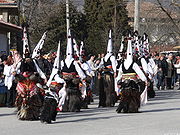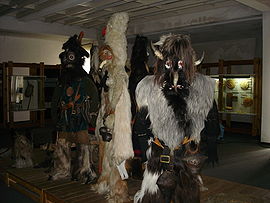
Kukeri
Encyclopedia



Bulgaria
Bulgaria , officially the Republic of Bulgaria , is a parliamentary democracy within a unitary constitutional republic in Southeast Europe. The country borders Romania to the north, Serbia and Macedonia to the west, Greece and Turkey to the south, as well as the Black Sea to the east...
n ritual to scare away evil spirits, with a costumed man performing the ritual. The costumes cover most of the body and include decorated wooden masks of animals (sometimes double-faced) and large bell
Bell (instrument)
A bell is a simple sound-making device. The bell is a percussion instrument and an idiophone. Its form is usually a hollow, cup-shaped object, which resonates upon being struck...
s attached to the belt. Around New Year
New Year
The New Year is the day that marks the time of the beginning of a new calendar year, and is the day on which the year count of the specific calendar used is incremented. For many cultures, the event is celebrated in some manner....
and before Lent
Lent
In the Christian tradition, Lent is the period of the liturgical year from Ash Wednesday to Easter. The traditional purpose of Lent is the preparation of the believer – through prayer, repentance, almsgiving and self-denial – for the annual commemoration during Holy Week of the Death and...
, the kukeri walk and dance through the village to scare evil spirits away with the costumes and the sound of the bells, as well as to provide a good harvest, health, and happiness to the village during the year.
The kukeri traditionally visit the peoples' houses at night so that "the sun would not catch them on the road." After going around the village they gather at the square to dance wildly and amuse the people. The ritual varies by region but its essence remains largely the same.
Distribution of the ritual and its materials
The ritual is attributed to ThracianThracians
The ancient Thracians were a group of Indo-European tribes inhabiting areas including Thrace in Southeastern Europe. They spoke the Thracian language – a scarcely attested branch of the Indo-European language family...
origins. Similar rituals can be also found in Romania
Romania
Romania is a country located at the crossroads of Central and Southeastern Europe, on the Lower Danube, within and outside the Carpathian arch, bordering on the Black Sea...
and Serbia
Serbia
Serbia , officially the Republic of Serbia , is a landlocked country located at the crossroads of Central and Southeast Europe, covering the southern part of the Carpathian basin and the central part of the Balkans...
. The masked goat-type figure is known as Capra in Moldavia
Moldavia
Moldavia is a geographic and historical region and former principality in Eastern Europe, corresponding to the territory between the Eastern Carpathians and the Dniester river...
, Brezaia in Muntenia
Muntenia
Muntenia is a historical province of Romania, usually considered Wallachia-proper . It is situated between the Danube , the Carpathian Mountains and Moldavia , and the Olt River to the west...
, Cerbul in Bucovina, and Turca in Transylvania
Transylvania
Transylvania is a historical region in the central part of Romania. Bounded on the east and south by the Carpathian mountain range, historical Transylvania extended in the west to the Apuseni Mountains; however, the term sometimes encompasses not only Transylvania proper, but also the historical...
. In Greek
Greek mythology
Greek mythology is the body of myths and legends belonging to the ancient Greeks, concerning their gods and heroes, the nature of the world, and the origins and significance of their own cult and ritual practices. They were a part of religion in ancient Greece...
Dionysos' cult, bacchanates would don the skins of sacrificed goat-kids. The death and resurrection of the Capra (goat) reflects the death and rebirth of vegetation. The Capra's chiseled wooden mask has a movable 'clamping' lower jaw for the lively dance, and its horns are either of wood or from a goat, ram, or stag. The horn's are adorned with girls' beads and kerchiefs, ribbons, multi-coloured tassles, mirrors, ivy
Ivy
Ivy, plural ivies is a genus of 12–15 species of evergreen climbing or ground-creeping woody plants in the family Araliaceae, native to western, central and southern Europe, Macaronesia, northwestern Africa and across central-southern Asia east to Japan and Taiwan.-Description:On level ground they...
(Hedera helix, a plant that is also considered sacred to Dionysos, used in thyrsus
Thyrsus
In Greek mythology, a thyrsus or thyrsos was a staff of giant fennel covered with ivy vines and leaves, sometimes wound with taeniae and always topped with a pine cone. These staffs were carried by Dionysus and his followers. Euripides wrote that honey dripped from the thyrsos staves that the...
staves), basil
Basil
Basil, or Sweet Basil, is a common name for the culinary herb Ocimum basilicum , of the family Lamiaceae , sometimes known as Saint Joseph's Wort in some English-speaking countries....
(Ocimum basilicum, a symbol of, inter alia, love in Italy
Italy
Italy , officially the Italian Republic languages]] under the European Charter for Regional or Minority Languages. In each of these, Italy's official name is as follows:;;;;;;;;), is a unitary parliamentary republic in South-Central Europe. To the north it borders France, Switzerland, Austria and...
and Romania
Romania
Romania is a country located at the crossroads of Central and Southeastern Europe, on the Lower Danube, within and outside the Carpathian arch, bordering on the Black Sea...
), natural or artificial flowers etc. The Capra's body may be made of different materials depending on local tradition, such as carpet or red cloth with adornments sewn on: traditional colourful cloth, embroidered handcerchiefs in Suceava
Suceava
Suceava is the Suceava County seat in Bukovina, Moldavia region, in north-eastern Romania. The city was the capital of the Principality of Moldavia from 1388 to 1565.-History:...
, beaded ornate women's textile girdles in Bacău
Bacau
Bacău is the main city in Bacău County, Romania. It covers a land surface of 43 km², and, as of January 1, 2009, has an estimated population of 177,087. The city is situated in the historical region of Moldavia, at the foothills of the Carpathian Mountains, and on the Bistriţa River...
, reed (Phragmites australis) seed heads in Botoşani
Botosani
Botoșani is the capital city of Botoșani County, in northern Moldavia, Romania. Today, it is best known as the birthplace of many celebrated Romanians, including Mihai Eminescu and Nicolae Iorga.- Origin of the name :...
and Iaşi
Iasi
Iași is the second most populous city and a municipality in Romania. Located in the historical Moldavia region, Iași has traditionally been one of the leading centres of Romanian social, cultural, academic and artistic life...
, goat pelts in Vrancea
Vrancea
Vrancea may refer to:* Vrancea County, Romania* Vrancea Mountains, Romania* Vrancea, a village in Burila Mare Commune, Mehedinţi County...
and in Mehedinţi, fabric ribbons or coloured paper in Neamţ
Neamt
Neamţ may refer to several entities in Romania:County* Neamţ CountyPlaces* Neamţ Citadel* Piatra Neamţ* Târgu NeamţMountain* Neamţ MountainsOther* Neamţ Monastery- See also :* Neamţu* Neamţu * Németh...
and in Giurgiu
Giurgiu
Giurgiu is the capital city of Giurgiu County, Romania, in the Greater Wallachia. It is situated amid mud-flats and marshes on the left bank of the Danube facing the Bulgarian city of Rousse on the opposite bank. Three small islands face the city, and a larger one shelters its port, Smarda...
etc.
Kuker
Kuker is a divinity personifying fecundity, sometimes in Bulgaria and Serbia it is a plural divinity. In Bulgaria, a ritual spectacle of spring (a sort of carnivalCarnival
Carnaval is a festive season which occurs immediately before Lent; the main events are usually during February. Carnaval typically involves a public celebration or parade combining some elements of a circus, mask and public street party...
) takes place after a scenario of folk theatre, in which Kuker's role is interpreted by a man attired in a sheep- or goat-pelt, wearing a horned mask and girded with a large wooden phallus
Phallus
A phallus is an erect penis, a penis-shaped object such as a dildo, or a mimetic image of an erect penis. Any object that symbolically resembles a penis may also be referred to as a phallus; however, such objects are more often referred to as being phallic...
. During the ritual, various physiological acts are interpreted, including the sexual act, as a symbol of the god's sacred marriage, while the symbolical wife, appearing pregnant, mimes the pains of giving birth. This ritual inaugurates the labours of the fields (ploughing, sowing
Sowing
Sowing is the process of planting seeds.-Plants which are usually sown:Among the major field crops, oats, wheat, and rye are sowed, grasses and legumes are seeded, and maize and soybeans are planted...
) and is carried out with the participation of numerous allegorical personages, among which is the Emperor and his entourage.
Honour
The rock formations of Kukeri NunataksKukeri Nunataks
Kukeri Nunataks are a pair of rocky peaks of elevation 320 m in middle Huron Glacier, Livingston Island...
on Livingston Island in the South Shetland Islands
South Shetland Islands
The South Shetland Islands are a group of Antarctic islands, lying about north of the Antarctic Peninsula, with a total area of . By the Antarctic Treaty of 1959, the Islands' sovereignty is neither recognized nor disputed by the signatories and they are free for use by any signatory for...
, Antarctica are named after the Bulgarian folkloric ritual of Kukeri.

